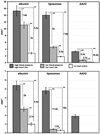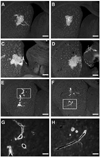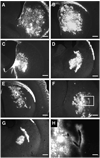The "perivascular pump" driven by arterial pulsation is a powerful mechanism for the distribution of therapeutic molecules within the brain
- PMID: 16650807
- PMCID: PMC2730223
- DOI: 10.1016/j.ymthe.2006.02.018
The "perivascular pump" driven by arterial pulsation is a powerful mechanism for the distribution of therapeutic molecules within the brain
Abstract
We investigated the movement of interstitially infused macromolecules within the central nervous system (CNS) in rats with high and low blood pressure (BP)/heart rate and in rats euthanized immediately before infusion (no heart action). Adeno-associated virus 2 (AAV2), fluorescent liposomes, or bovine serum albumin was infused into rat striatum (six hemispheres per group) by convection-enhanced delivery (CED). After infusion, distribution volumes were evaluated. The rats with high BP/heart rate displayed a significantly larger distribution of the infused molecules within the injected site and more extensive transport of those molecules to the globus pallidus. This difference was particularly apparent for AAV2, for which a 16.5-fold greater distribution of viral capsids was observed in the rats with high BP/heart rate than in the rats with no heartbeat. Similar results were observed for liposomes, despite their larger diameter. The distribution of all infused molecules in all rats that had low or no blood flow was confined to the space around brain blood vessels. These findings show that fluid circulation within the CNS through the perivascular space is the primary mechanism by which viral particles and other therapeutic agents administered by CED are spread within the brain and that cardiac contractions power this process.
Figures



Similar articles
-
Effects of the perivascular space on convection-enhanced delivery of liposomes in primate putamen.Exp Neurol. 2005 Nov;196(1):104-11. doi: 10.1016/j.expneurol.2005.07.009. Epub 2005 Aug 16. Exp Neurol. 2005. PMID: 16109410
-
Real-time imaging of convection-enhanced delivery of viruses and virus-sized particles.J Neurosurg. 2007 Sep;107(3):560-7. doi: 10.3171/JNS-07/09/0560. J Neurosurg. 2007. PMID: 17886556
-
Extensive distribution of liposomes in rodent brains and brain tumors following convection-enhanced delivery.J Neurooncol. 2004 May;68(1):1-9. doi: 10.1023/b:neon.0000024743.56415.4b. J Neurooncol. 2004. PMID: 15174514
-
The use of convection-enhanced delivery with liposomal toxins in neurooncology.Toxins (Basel). 2011 Apr;3(4):369-97. doi: 10.3390/toxins3040369. Epub 2011 Mar 31. Toxins (Basel). 2011. PMID: 22069714 Free PMC article. Review.
-
Real-time imaging and quantification of brain delivery of liposomes.Pharm Res. 2006 Nov;23(11):2493-504. doi: 10.1007/s11095-006-9103-5. Epub 2006 Sep 14. Pharm Res. 2006. PMID: 16972184 Review.
Cited by
-
Uncertainty quantification of parenchymal tracer distribution using random diffusion and convective velocity fields.Fluids Barriers CNS. 2019 Sep 30;16(1):32. doi: 10.1186/s12987-019-0152-7. Fluids Barriers CNS. 2019. PMID: 31564250 Free PMC article.
-
The glymphatic hypothesis: the theory and the evidence.Fluids Barriers CNS. 2022 Feb 3;19(1):9. doi: 10.1186/s12987-021-00282-z. Fluids Barriers CNS. 2022. PMID: 35115036 Free PMC article. Review.
-
Flow of cerebrospinal fluid is driven by arterial pulsations and is reduced in hypertension.Nat Commun. 2018 Nov 19;9(1):4878. doi: 10.1038/s41467-018-07318-3. Nat Commun. 2018. PMID: 30451853 Free PMC article.
-
Peristaltic pumping in thin non-axisymmetric annular tubes.J Fluid Mech. 2021 Jun 25;917:A10. doi: 10.1017/jfm.2021.277. Epub 2021 Apr 23. J Fluid Mech. 2021. PMID: 35310826 Free PMC article.
-
Impaired Glymphatic Transport in Spontaneously Hypertensive Rats.J Neurosci. 2019 Aug 7;39(32):6365-6377. doi: 10.1523/JNEUROSCI.1974-18.2019. Epub 2019 Jun 17. J Neurosci. 2019. PMID: 31209176 Free PMC article.
References
-
- Kaspar BK, et al. Targeted retrograde gene delivery for neuronal protection. Mol. Ther. 2002;5:50–56. - PubMed
-
- Tsiang H. Evidence for an intraaxonal transport of fixed and street rabies virus. J. Neuropathol. Exp. Neurol. 1979;38:286–299. - PubMed
-
- Lascano EF, Berria MI. Histological study of the progression of herpes simplex virus in mice. Arch. Virol. 1980;64:67–79. - PubMed
-
- Kristensson K, Nennesmo L, Persson L, Lycke E. Neuron to neuron transmission of herpes simplex virus: transport of virus from skin to brainstem nuclei. J. Neurol. Sci. 1982;54:149–156. - PubMed
Publication types
MeSH terms
Substances
Grants and funding
LinkOut - more resources
Full Text Sources
Other Literature Sources

